Out and about in Wexford last week there was spring barley heading for flag leaf, spring barley being planted, clean wheat after its T2 fungicide and everything in between.
Spring barley dominated the agenda for George Blackburn on Thursday 18 May and while we were in the heart of spring barley country, travelling from north to south, there were some nice crops powering on in the 16°C temperatures, but the wet spring and delayed drilling had clearly taken its toll on some crops.

February-sown spring barley with some flag leaves emerged.
Crops at the three- to four-leaf stage and early tillering needed a little bit of minding and this was evidenced in the recommendations being prescribed. Weeds were slow to emerge in many crops, but with temperatures climbing up to allow aphids to fly and late drilling dates, an aphicide was needed.
To help the crop along that aphicide at 50ml/ha was recommended with 1l/ha of Phylgreen (seaweed) to help reduce stress, manganese where needed at 1L/ha and where wild oats or canary grass are an issue Axial Pro was added as well.
Once happy that the plants are up, an early application of Axial Pro allows for a lower rate to be used. There is also an issue with resistant wild oats in many crops in the area, so applying before the weeds get too strong is important.
CeCeCe at 0.5l/ha was generally being applied to all crops at the weed spray timing to even up thin patches and promote tillers and on the earlier-sown crops visited, the benefit of that plant growth regulator application was clear to see.
George recommended the broadleaved weed spray a week later when the weeds have a bit more leaf cover. There was a wide spectrum of weeds across the day from speedwell and chickweed to fumitory and volunteer rape. Some can be seen in the pictures.
Where crops were tillering, a fungicide was recommended and in some cases at a low rate to be followed by a second low rate to keep disease at bay, effectively splitting the T1 fungicide into two parts. Coyote was the main product in use which has prothioconazole and two strobilurins. Strobilurins were essential in any Planet for net blotch control.

Rhynchosporium was stopped in its tracks on this February-sown barley.
One February-sown spring barley crop was a picture and while there might have been a few bare patches at the gate there was loads of potential in the field.
Net blotch and rhynchosporium had tried to get going but were stopped with a timely fungicide earlier last week.
Geraldine was the main variety of the day and it looked clean with no signs of disease, despite reports of net blotch across the country. George described it as a vigorous variety that you need to keep on top of.

Bindweed in spring barley.

A great crop of early-April sown barley with a tiny bit of BYDV.
Sowing
As we travelled south, Curracloe Farms were planting spring barley in the sloblands with some big machinery, all of which is needed on land which takes a long time to dry out, but has great yield potential and at current temperatures the crop will be up in no time.
There are some issues with resistant ryegrass in the fields that were being planted so George will recommend a pre-emergence herbicide here.
Leather jackets
There was plenty of leather jacket damage across fields, not just after grass. Most was insignificant, but in this field after grass leather jackets had really done plenty of damage.

Leather jacket damage in a crop of spring barley.
BYDV
BYDV levels in winter crops were low and while there were bits and pieces of yellow leaves showing, it was mainly a small number of leaves here and there in crops. Some BYDV was showing in early-April sown spring barley.
Spring oats
Spring oats was another crop on the agenda and once again sowing rates varied.
Some crops had herbicide and plant growth regulator applied and were almost at their second growth regulator application, but more are only getting off the ground.

Spring oats sown on 22 April in a minimum tillage system. Weed levels were low.
Most looked mighty despite the late sowing, however. The crop in the picture is on Furlong’s farm and was planted on 22 April.
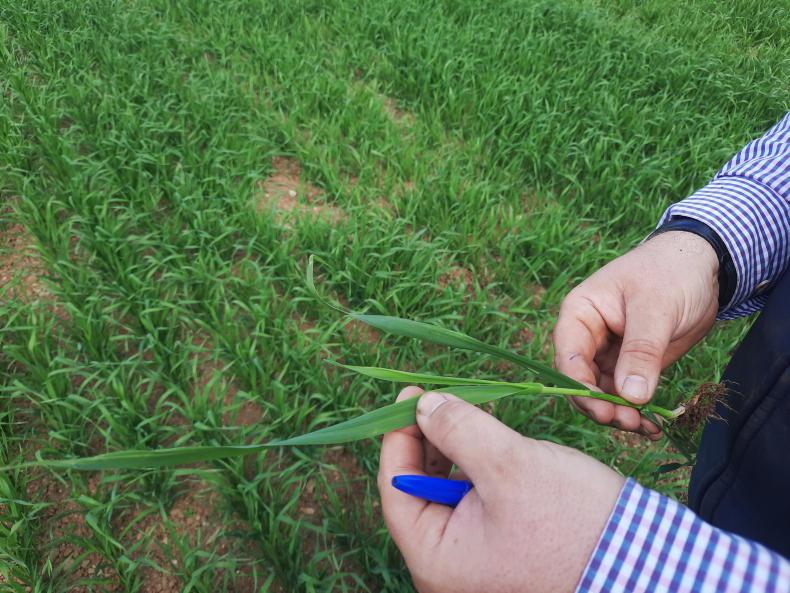
Spring oats heading for second node, due growth regulator seven days after the picture was taken.
Emergence was even and weed numbers were low, something George put down to being in minimum tillage for a number of years. Diverse cover crop mixes are part of the normal routine on this ground. For a spring oats crop sown in late April this really was looking well.
Winter wheat
We saw just one crop of winter wheat as T2s were wrapped up the previous week. Inatreq was the product of choice for those T2s, along with a multisite and phylgreen. Revystar had been used for the majority of T1s.

A clean crop of Champion winter wheat with great potential with wide leaves.
The crop of wheat we looked at was for seed and the variety was Champion. It was clean, a little bit of septoria was evident in the base, but had not travelled. The crop had very wide leaves with plenty of yield potential.
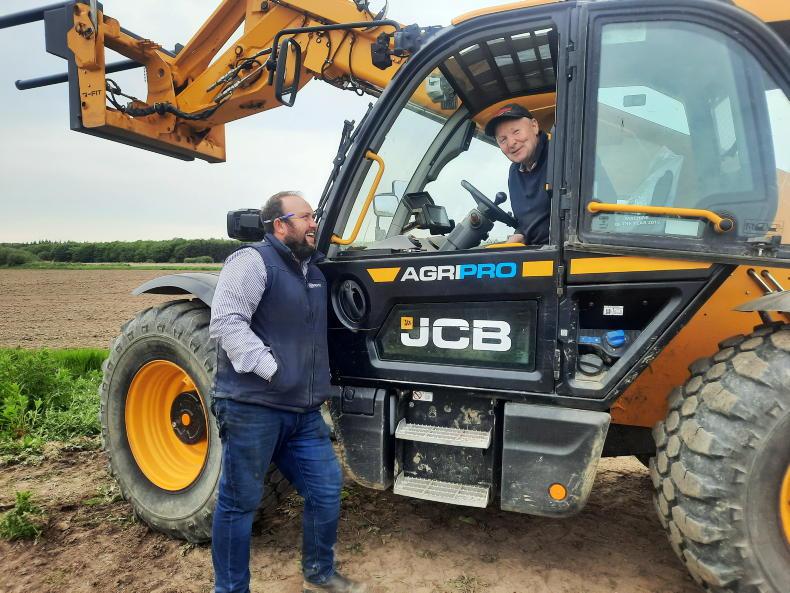
George Blackburn chatting to Simon Donohoe of Curracloe Farms. Simon was delivering the last of the spring barley seed to Pat O'Connor on land at the sloblands in south Wexford on 18 May.
George writes all recommendations in the field once crops have been walked. They are emailed straight to the office and filed. The required spray is put together immediately for each grower and delivered to the farm by Cooney Furlong Grain with the recommendation. All this generally happens within the same day and really is a valuable service for farmers at a very busy time of year.
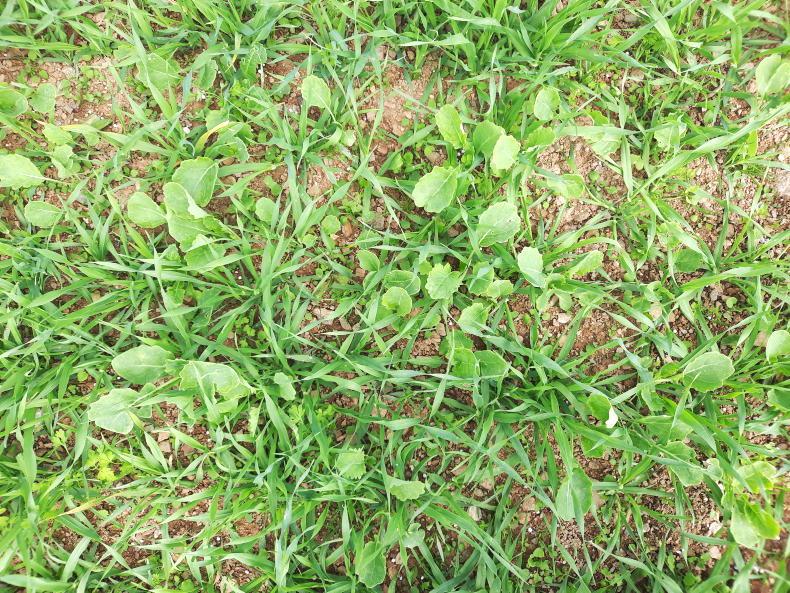
Volunteer rape in spring barley.
Crops vary hugely in growth stages.Some spring barley crops appear stressed.Crops are likely to grow quickly this time of year so the T1 fungicide was being split in two to keep disease at bay.The gate is shut on winter barley and winter oilseed rape.Septoria looks to be under control in winter wheat at present. Recent dry weather has helped to keep disease pressure down.To hear George talking about the crops he was walking, listen here.
Out and about in Wexford last week there was spring barley heading for flag leaf, spring barley being planted, clean wheat after its T2 fungicide and everything in between.
Spring barley dominated the agenda for George Blackburn on Thursday 18 May and while we were in the heart of spring barley country, travelling from north to south, there were some nice crops powering on in the 16°C temperatures, but the wet spring and delayed drilling had clearly taken its toll on some crops.

February-sown spring barley with some flag leaves emerged.
Crops at the three- to four-leaf stage and early tillering needed a little bit of minding and this was evidenced in the recommendations being prescribed. Weeds were slow to emerge in many crops, but with temperatures climbing up to allow aphids to fly and late drilling dates, an aphicide was needed.
To help the crop along that aphicide at 50ml/ha was recommended with 1l/ha of Phylgreen (seaweed) to help reduce stress, manganese where needed at 1L/ha and where wild oats or canary grass are an issue Axial Pro was added as well.
Once happy that the plants are up, an early application of Axial Pro allows for a lower rate to be used. There is also an issue with resistant wild oats in many crops in the area, so applying before the weeds get too strong is important.
CeCeCe at 0.5l/ha was generally being applied to all crops at the weed spray timing to even up thin patches and promote tillers and on the earlier-sown crops visited, the benefit of that plant growth regulator application was clear to see.
George recommended the broadleaved weed spray a week later when the weeds have a bit more leaf cover. There was a wide spectrum of weeds across the day from speedwell and chickweed to fumitory and volunteer rape. Some can be seen in the pictures.
Where crops were tillering, a fungicide was recommended and in some cases at a low rate to be followed by a second low rate to keep disease at bay, effectively splitting the T1 fungicide into two parts. Coyote was the main product in use which has prothioconazole and two strobilurins. Strobilurins were essential in any Planet for net blotch control.

Rhynchosporium was stopped in its tracks on this February-sown barley.
One February-sown spring barley crop was a picture and while there might have been a few bare patches at the gate there was loads of potential in the field.
Net blotch and rhynchosporium had tried to get going but were stopped with a timely fungicide earlier last week.
Geraldine was the main variety of the day and it looked clean with no signs of disease, despite reports of net blotch across the country. George described it as a vigorous variety that you need to keep on top of.

Bindweed in spring barley.

A great crop of early-April sown barley with a tiny bit of BYDV.
Sowing
As we travelled south, Curracloe Farms were planting spring barley in the sloblands with some big machinery, all of which is needed on land which takes a long time to dry out, but has great yield potential and at current temperatures the crop will be up in no time.
There are some issues with resistant ryegrass in the fields that were being planted so George will recommend a pre-emergence herbicide here.
Leather jackets
There was plenty of leather jacket damage across fields, not just after grass. Most was insignificant, but in this field after grass leather jackets had really done plenty of damage.

Leather jacket damage in a crop of spring barley.
BYDV
BYDV levels in winter crops were low and while there were bits and pieces of yellow leaves showing, it was mainly a small number of leaves here and there in crops. Some BYDV was showing in early-April sown spring barley.
Spring oats
Spring oats was another crop on the agenda and once again sowing rates varied.
Some crops had herbicide and plant growth regulator applied and were almost at their second growth regulator application, but more are only getting off the ground.

Spring oats sown on 22 April in a minimum tillage system. Weed levels were low.
Most looked mighty despite the late sowing, however. The crop in the picture is on Furlong’s farm and was planted on 22 April.

Spring oats heading for second node, due growth regulator seven days after the picture was taken.
Emergence was even and weed numbers were low, something George put down to being in minimum tillage for a number of years. Diverse cover crop mixes are part of the normal routine on this ground. For a spring oats crop sown in late April this really was looking well.
Winter wheat
We saw just one crop of winter wheat as T2s were wrapped up the previous week. Inatreq was the product of choice for those T2s, along with a multisite and phylgreen. Revystar had been used for the majority of T1s.

A clean crop of Champion winter wheat with great potential with wide leaves.
The crop of wheat we looked at was for seed and the variety was Champion. It was clean, a little bit of septoria was evident in the base, but had not travelled. The crop had very wide leaves with plenty of yield potential.

George Blackburn chatting to Simon Donohoe of Curracloe Farms. Simon was delivering the last of the spring barley seed to Pat O'Connor on land at the sloblands in south Wexford on 18 May.
George writes all recommendations in the field once crops have been walked. They are emailed straight to the office and filed. The required spray is put together immediately for each grower and delivered to the farm by Cooney Furlong Grain with the recommendation. All this generally happens within the same day and really is a valuable service for farmers at a very busy time of year.

Volunteer rape in spring barley.
Crops vary hugely in growth stages.Some spring barley crops appear stressed.Crops are likely to grow quickly this time of year so the T1 fungicide was being split in two to keep disease at bay.The gate is shut on winter barley and winter oilseed rape.Septoria looks to be under control in winter wheat at present. Recent dry weather has helped to keep disease pressure down.To hear George talking about the crops he was walking, listen here.














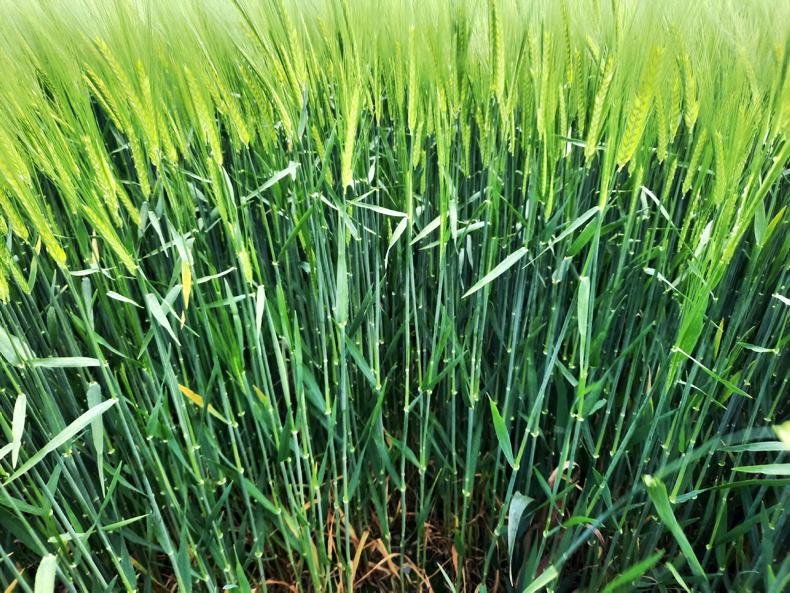


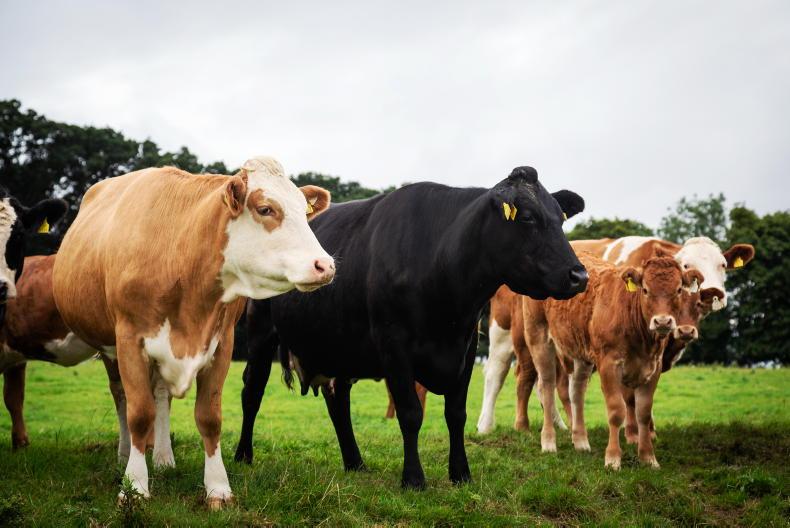
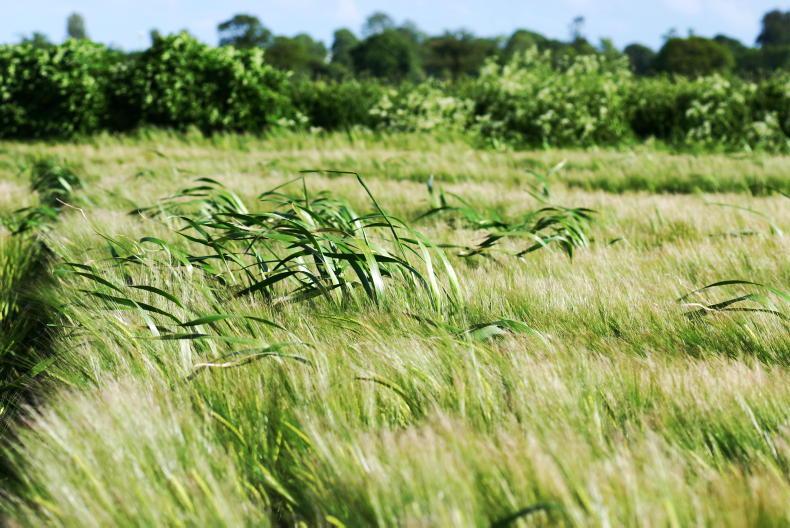
SHARING OPTIONS